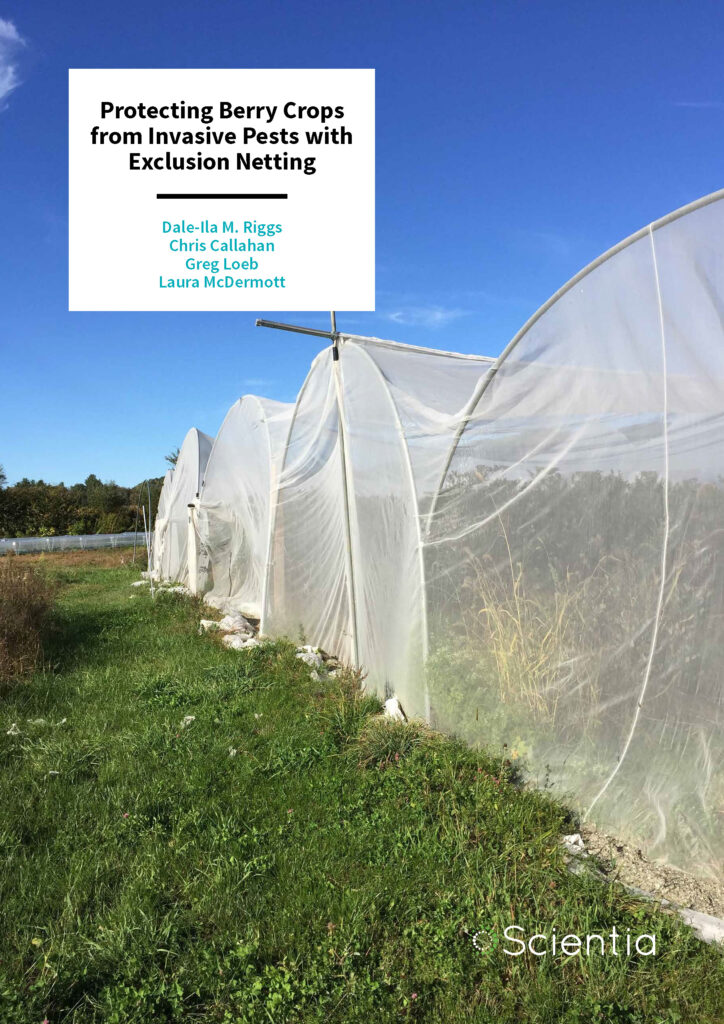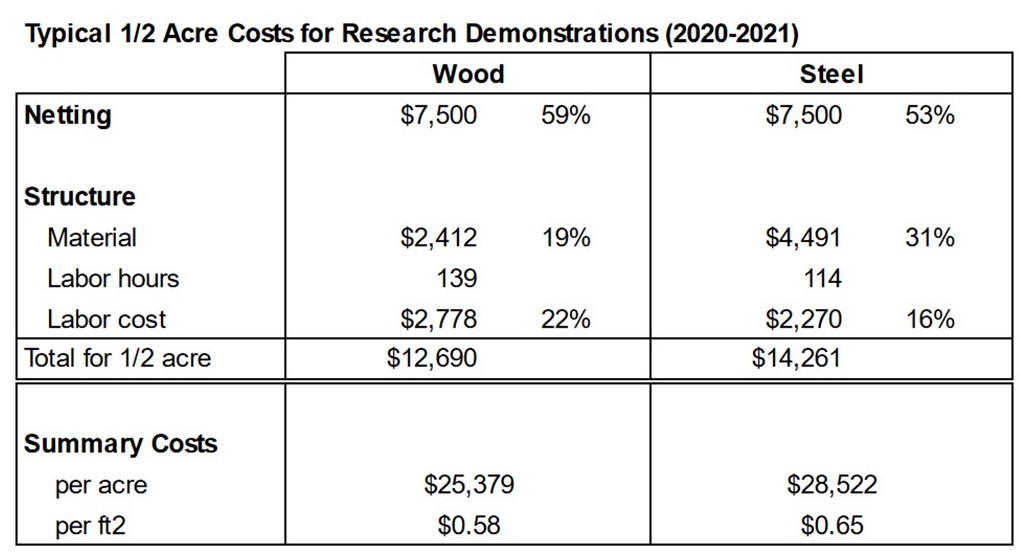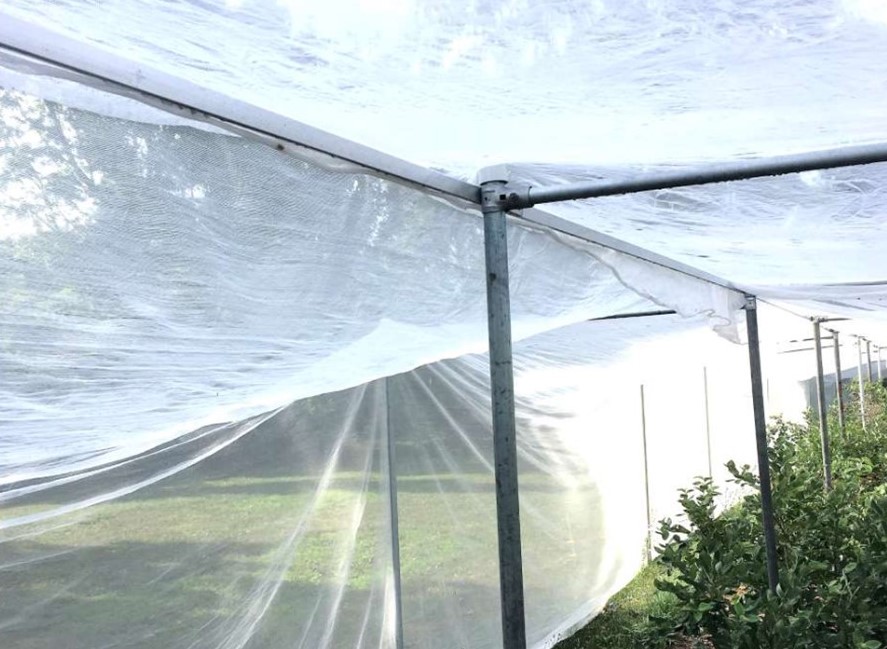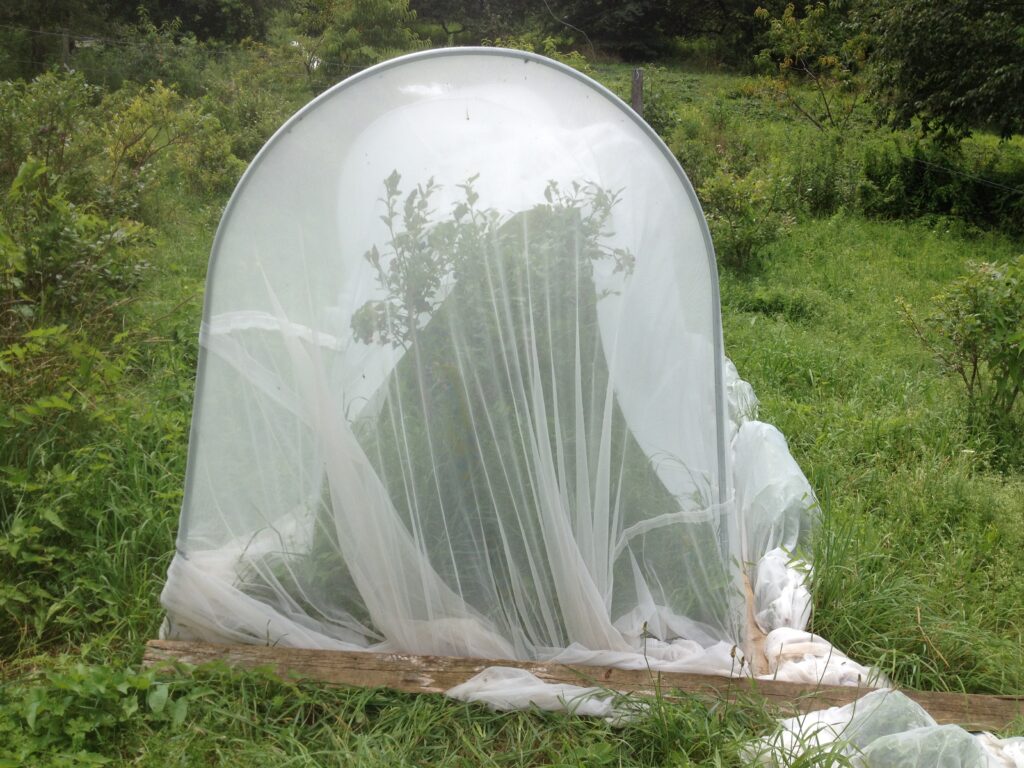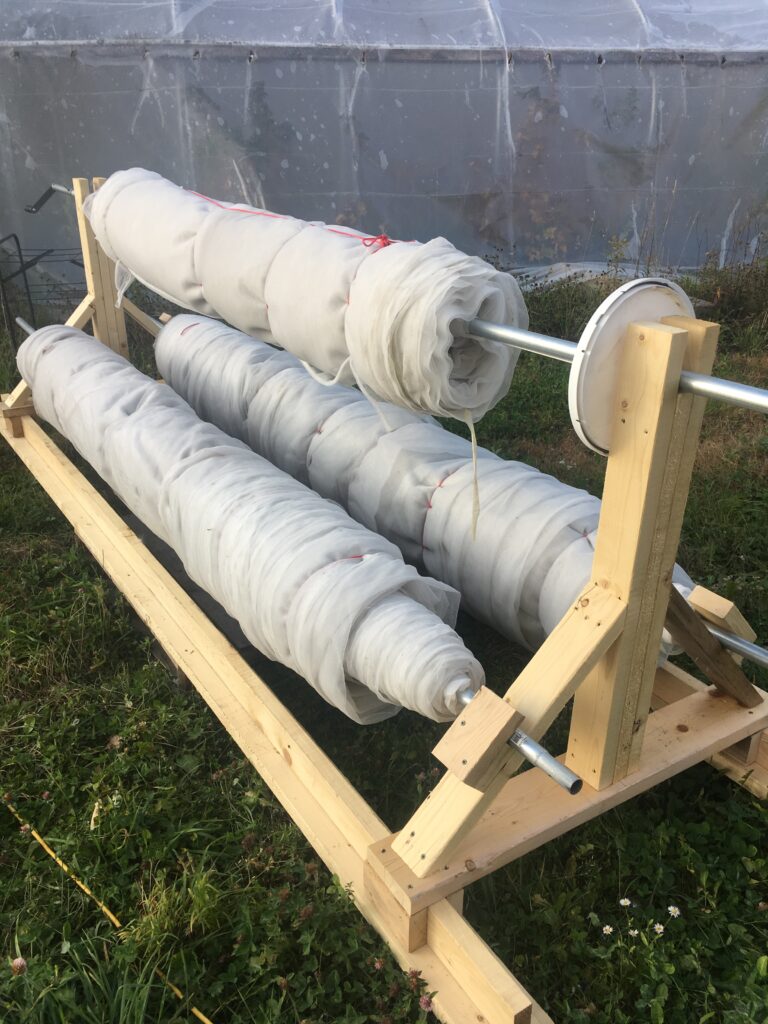If you grow berry crops you’ve most likely heard of spotted wing drosophila (SWD, Drosophila suzukii). This invasive pest has caused significant crop losses in the region since at least 2011. While there are chemical pesticides with varied efficacy, one practice that we’ve focused on is physical exclusion with netting. Pioneered in the region by Dale Ila Riggs at The Berry Patch and Berry Protection Solutions in Stephentown, NY, exclusion netting structures and systems have been very effective against SWD when implemented well. A summary article from Scientia is also available.
Netting
Crop damage is cause by adult females laying eggs in ripe fruit. These adult females have an approximately 1.0 mm diameter torso and are 2.0 mm long. Based on our experience, the netting should have openings less than 1.0 mm in at least one direction. A sampling of currently (2022) available netting and screen that meets this requirement follows:
- TekKnit ExcludeNet 85 gr (R2503ED) – polyethylene netting – 0.60 x 1.05 mm openings
- ProtekNet 70 gr – polyethylene netting – 0.85 x 1.4 mm openings
- ProtekNet 56 gr – polypropylene netting – 0.25 x 0.73 mm openings
- ProtekNet 25 gr – polyamid netting – 0.35 x 0.35 mm openings
- ProtekNet 17 gr – polyamide netting – 0.85 x 0.85 mm openings
- Saint-Gobain / Adfors – fiberglass small insect window screen – 0.94 x 0.94 mm openings
Structure
Lots of different approaches have been successfully used to support the netting, prevent uplift failure in wind storms, and keep the netting off of plants. Some growers have used 1″ electrical conduit (“electrical metal tubing” or EMT). Some growers have simply draped the netting on the bushes for small plantings.
Our research has explored an approach known as a “cable garden” or “post and wire trellis.” Over the past three years we have tried different approaches and have worked with GinTech Shade Technologies (structure design and materials) and TekKnit Industries (netting manufacturer) to refine the design and work to reduce costs.
Costs
A netting system comes with mainly one-time, fixed installation costs that should provide crop protection and reduce recurring spraying costs (and associated labor).
Our research demonstrations using cable garden structures penciled out at $0.58 – 0.65 per square foot ($25,264 – 28,314 per acre).
Other on-farm builds cost $0.43 – 0.51 per square foot ($18,730 – 22,215 per acre). In either case, the netting is the bulk of the cost.
Depending on markets, pricing, and extent of SWD damage resulting in crop loss without netting, growers have reported 1-3 year payback periods on this practice. Assuming a life of 8 years for the netting and 20 years for the structure results in an amortized annual cost for the cable garden systems of $2,394 – 2,551 per acre. Netting is the main part of the system that will need maintenance and replacement and warranty varies by product.
Timing
Vulnerable crops should be covered by netting after the bulk of pollination has occurred, but before fruit starts to color. You can check on past timing of SWD sightings using the the historical sighting maps housed at the Cornell IPM SWD blog. If you deploy netting too early, you exclude beneficial pollinators. If you deploy too late, you may miss the chance to exclude SWD.
It may go without saying, but the time to start building an exclusion netting structure is well ahead of when it is needed!
If you want to know the timing of SWD in your location more precisely, consider setting and monitoring lure traps as shown in the video below.
“How To” Videos for Structure and Netting
We are compiling a series of videos showing how we built two wooden post and steel post SWD netting structures in partnership with GinTech Shade Technologies as research demonstrations.
Videos available so far:
- Complete playlist on YouTube – go.uvm.edu/swdvideos
- Overview of SWD Netting Trials (19:59)
- Basic Layout (11:45)
- Posts, Auguring Holes, Driving Anchors (17:45)
- Setting Perimeter Posts and Tightening Cables (29:47)
- Installing Netting Panels, Thinking about Vestibules, and Planning for Winter Storage (17:26)
To drive the helical earth anchors, it will be helpful to have an adapter. The one we built is summarized in a set of plans which you can download.
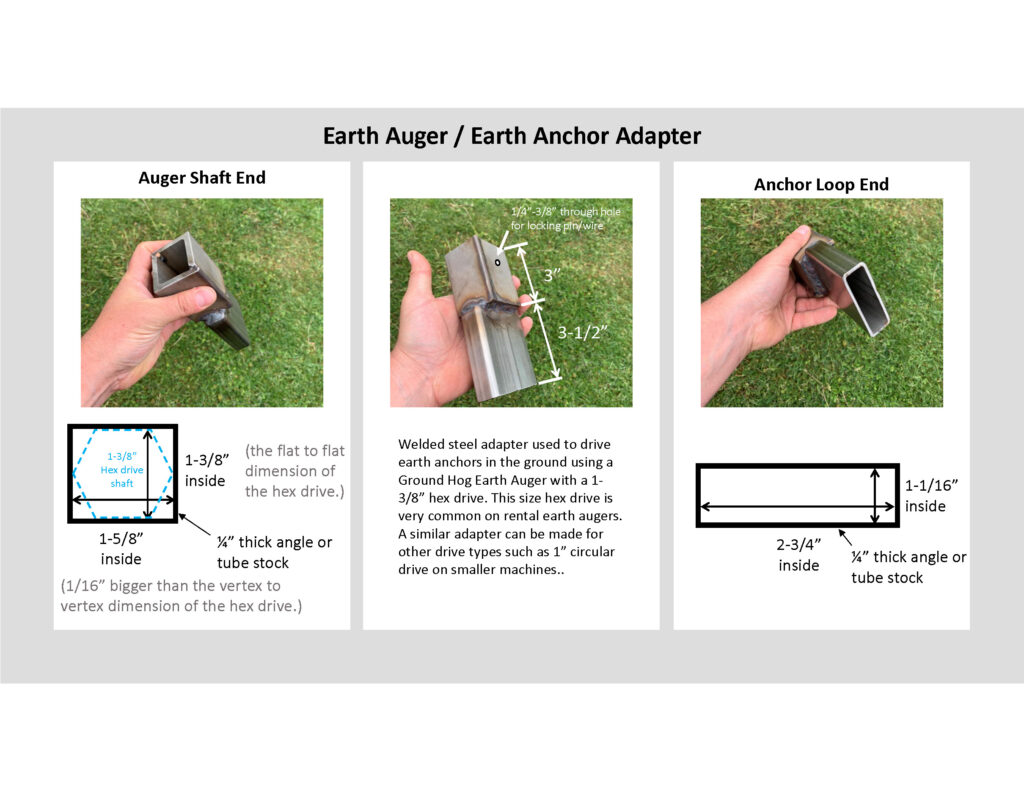
Other examples of structures used by growers are highlighted in the recording and slides from a 2020 UVM Extension VT Vegetable and Berry Grower Association Webinar.
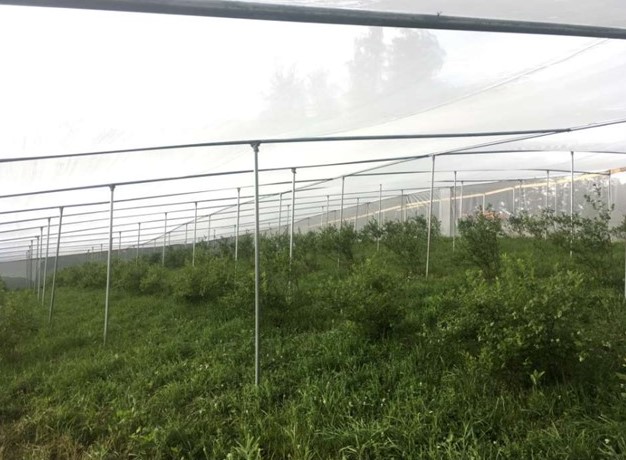
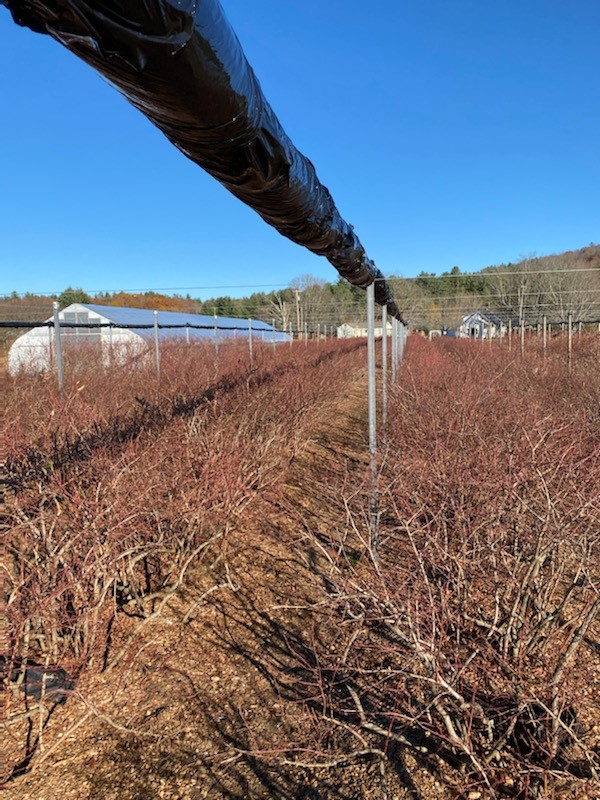
Other Resources
Cornell University SWD Blog – Frequent updates during the season, historical sighting maps for the northeast region.
Cornell Fruit Resources: SWD Guide – In depth background on the pest.
Michigan State University SWD Identification Guide – Photo-based guide to identification and differentiation.
Pennsylvania State University SWD Guide – Includes look-alike species for differentiation.
University of New Hampshire SWD Guide – Includes weekly scouting reports.
University of Maine SWD Guide – Focused on Wild Blueberries
University of Massachusetts SWD Guide – Identification, biology, monitoring, and management.
University of Vermont / Vermont Vegetable and Berry Growers Association SWD Resource List – A clearinghouse of SWD resources.

